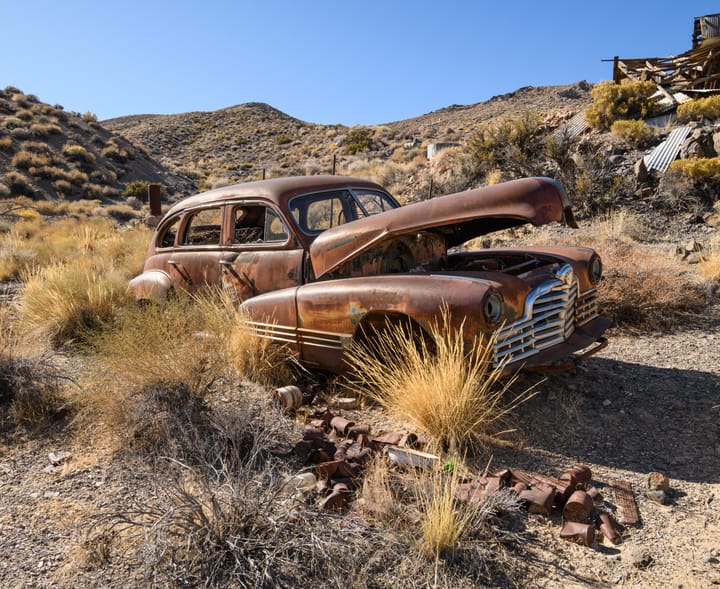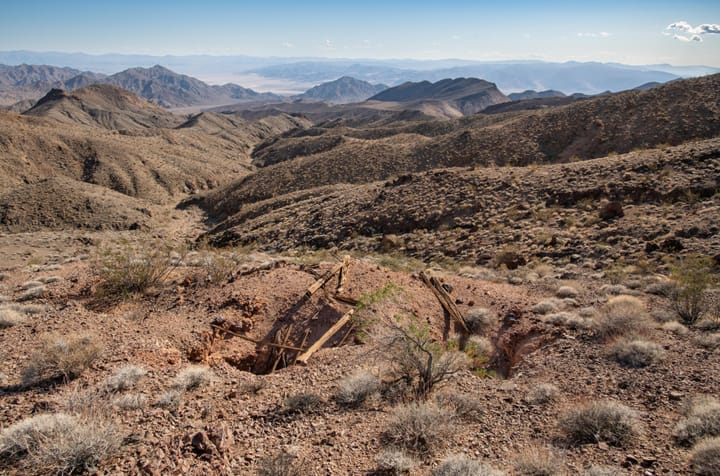In 2013, I joined a Searles Valley Historical Society field trip to see the well-preserved borax mining camp of Ryan in Death Valley. Having never been in the mining camp before, I jumped at the chance to visit.

Francis Marion Smith founded the Pacific Coast Borax Company in 1890. He bought out William Tell Coleman’s borate deposits around Death Valley and the region, including the Harmony Borax Works, and consolidated them into Pacific Coast Borax. Borax had become famous under Coleman for the 20 mule teams which he used to transport it from Furnace Creek to Mojave and Daggett in the 1880s. Smith continued to use the mule teams occasionally but, by August 1907, he had replaced them with his Tonopah and Tidewater Railroad. The 20 Mule Team name, however, was kept and heavily marketed.
In 1914 with other borate deposits becoming exhausted, Pacific Coast Borax turned its attention to its Hillside claims, these would soon become the six mines at Ryan. The Death Valley Railroad (a 36 inch narrow gauge line) was built from Death Valley Junction to Ryan and three mines; the Played Out, Upper Biddy McCarthy and Lower Biddy McCarthy, began producing and shipping borate ores. The other trio of Ryan mines; the Grand View, Lizzie V. Oakley, and Widow were slightly farther south. A 24 inch Baby Gauge railway line was built to connect these mines to the Upper Biddy and, by 1918, the Baby Gauge had reached all the way to the Widow, a distance of about three miles. The next ten years were the heyday of the mining camp.

By 1927, the Pacific Coast Borax Company began to develop a massive deposit of borate minerals at Boron near Kramer Junction. This ore body was easier to mine, process and get to market and thus more economical to work. The company soon relocated their operations there and ended all mining at Ryan. With the mines closed; Ryan, the Death Valley Railroad, the Baby Gauge and the whole Tonopah and Tidewater railroad had little reason to exist. Instead of scrapping them, however, Pacific Coast Borax decided to develop the mining camp into a hotel to draw tourists to Death Valley. The mine camp turned into the Death Valley View Hotel. Soon after, the company built the Furnace Creek Inn and Greenland Ranch was renovated and improved into the Furnace Creek Ranch.
Things seemed like they might be looking up, but without the borate traffic, the DVRR wasn’t economical to support. Pacific Coast Borax transferred the DVRR rolling stock to another mine in New Mexico. Ryan lost its convenient rail transportation of water and it had to be hauled in by truck. The hotel’s plight was further complicated with the coming of the automobile; people didn’t need to depend on riding a railroad to see Death Valley. The Furnace Creek Inn and Ranch were closer to the valley and the road. These factors and the stock market crash of 1929 with the following Great Depression put an end to the majority of the tourist business at the Death Valley View Hotel. It continued on in a minor way as overflow lodging for the Furnace Creek properties into the early 1950s. The Baby Gauge ran tours until 1949 when it was finally shut down. Caretakers stayed on site and maintained the camp.

Through mergers and acquisitions, Pacific Coast Borax eventually became US Borax and then was bought by Rio Tinto in 1967. In April 2013, Rio Tinto generously donated the Ryan mining camp and property as well as funding to assist with its long-term preservation and restoration to the non-profit Death Valley Conservancy (DVC). The camp has remained intact over the years and it is clear that Rio Tinto desired to carry on the long tradition of preservation at Ryan. The Death Valley Conservancy has been busy with research, planning, and initial preservation and restoration work. Their mantra for the Ryan project is "to preserve what is left and restore where possible." The DVC hosts various groups for historical archeological research, historic preservation study, and related fields at the site. To quote a statement from the DVC:
The ultimate goal for Ryan is for it to function as a world-class facility supporting scientific research and education in historic preservation, archaeology, and history. All stabilization, restoration, and other construction activities are guided by the Secretary of the Interior’s Standards for the Treatment of Historic Properties, Standards and Guidelines for Archaeology and Historic Preservation, and Guidelines for the Treatment of Cultural Landscapes.
As critical structural, preservation, restoration, and other safety projects progress, the DVC will work towards offering more public tours. For more information on historic mining camp of Ryan and the DVC, please visit Death Valley Conservancy or Ryan Camp.

Please note that the mining camp, the mines, and the Baby Gauge track around Ryan are not a part of Death Valley National Park and remain private property. Please do not trespass. Staff lives there full-time.
I would like to thank Scott Smith and the staff at Ryan for their hospitality and extensive historical knowledge of the mining camp. We had a fantastic day!



